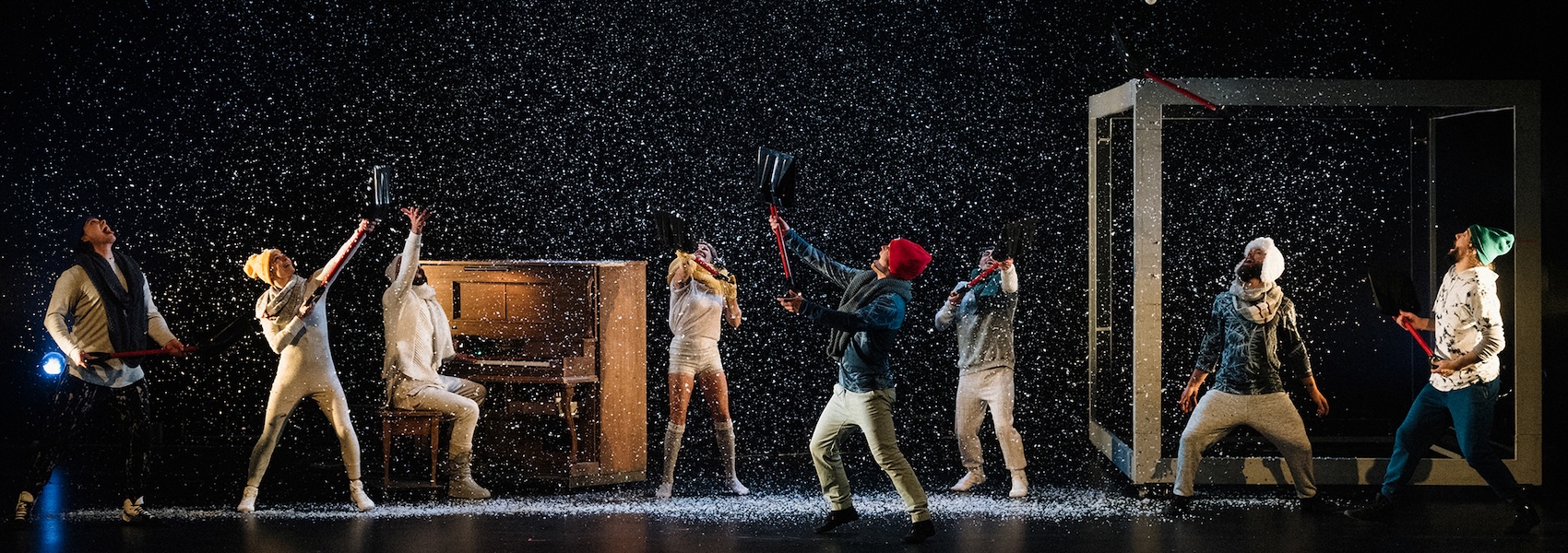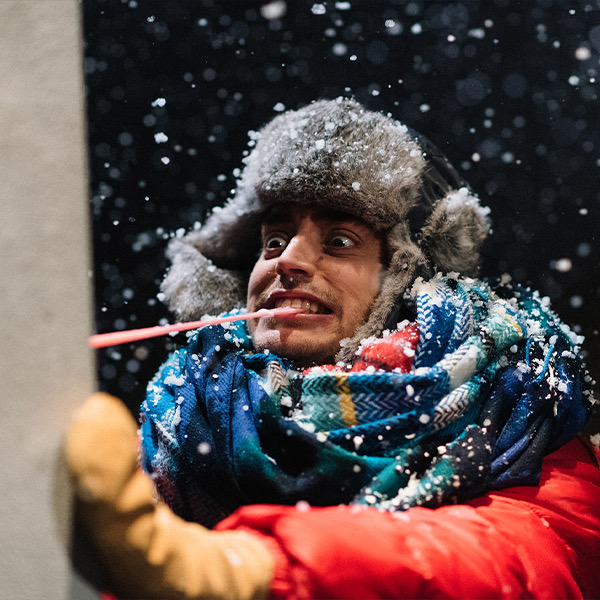Cirque Flip Fabrique: Blizzard
- Thursday, February 12, 7:30 p.m.
- Frederick C. Tillis Performance Hall
Imagine a storm so powerful it creates a wintery canvas from which anything is possible. Now, allow your students to step into the mesmerizing world of Blizzard by Cirque Flip Fabrique, where acrobatics, artistry, and awe-inspiring performances combine to create a thought-provoking and unforgettable experience of visual poetry.
What Will My Students Experience?
A Cirque Flip Fabrique performance is not just entertainment—it's an educational journey that combines art, culture, and physical prowess in a way that captivates and inspires.
During this fifty minute live performance, your students will experience:
-
A seamless blend of international acrobatics, visual poetry, and storytelling
-
An introduction to Québec's cultural heritage and contemporary circus arts
-
Incredible physical feats demonstrated through acrobatic dance, humorous vignettes, and aerial stunt performances
-
Stunning visual elements that enhance storytelling and artistic expression
-
An immersive auditory experience with live music
What Will My Students Learn?
Regardless of what grade level you teach, there are many ways to use the Cirque Flip Fabrique performance to supplement and enhance what your students are already learning.
Here are few ideas to help you get started:
-
Inspire literature and creative writing students to explore the concept of visual poetry, analyzing how the performance uses visual elements to enhance storytelling.
-
Prompt music students to analyze the role of live music in the performance, discussing how composer Ben Nesrallah's music enhances the emotional and thematic elements of the show.
-
Encourage history and social studies students to analyze the cultural significance of modern circus arts in Québec and how Blizzard reflects aspects of Québec's heritage and contemporary artistic expression.
-
Discuss the visual aesthetics of the show with art and design students, including scenic design, lighting, and costumes, and how these aesthetics contribute to the storytelling.
-
Encourage theater arts students to create their own set designs or costumes inspired by the themes of Blizzard.
Please scroll down to the section titled “Educational Standards Alignment” for a list of relevant standards selected from state and national frameworks.
What Do I Need to Know?
Cirque Flip Fabrique
Cirque Flip Fabrique is a contemporary circus company based in Québec, Canada. It was founded in 2011 by a group of seven friends and circus performers. The troupe emerged from their shared dreams and friendship, quickly gaining recognition for their unique blend of acrobatics and visual poetry. Over the years, Cirque Flip Fabrique has become a prominent player in the circus arts scene, both in Québec and internationally.
History of Circus Arts in
Canada
Although the circus itself has a rich history dating back to ancient times, the province of Québec has its own history with circus arts. This history dates to the late eighteenth century when British squire John Bill Ricketts introduced circus performances to the region.
John Bill Ricketts was an English equestrian and circus performer who is credited with bringing the first modern circus to North America. He began his theatrical career with the Royal Circus and Equestrian Philharmonic Academy in London during the 1780s.
In 1792, Ricketts emigrated to the United States and established his first circus in Philadelphia. He later expanded his performances to various towns in New England and Canada, including Montréal, where he established Canada’s first circus in 1797.
Circus Arts in Canada Today
Today, the province of Québec has embraced circus arts as a significant part of its cultural identity. Companies like Cirque du Soleil, Cirque Éloize, and Les 7 Doigts de la Main have become global ambassadors of Québec's unique blend of traditional and contemporary circus arts.
The circus industry is also a major economic driver in Québec. Cirque du Soleil, for example, has grown into a billion-dollar enterprise, creating jobs and attracting tourism.
Today, Québec is known for its role in educating circus performers from around the world. It is home to the National Circus School in Montréal, the only state-funded elite circus training institution in North America. This school attracts students from around the world and ensures the continuous development of circus arts.
A Closer Look
Visual poetry is a style of poetry that incorporates graphic and visual design elements to convey its meaning.
This form of poetry combines visual art and written expression, creating new ways of presenting and interpreting poetry. Visual poetry often uses typography, color, shape, and other visual elements as primary bearers of intent and meaning, inviting readers to consider the visual arrangement of words and letters as integral to the poem's message.
Cirque Flip Fabrique uses the term visual poetry to define its work because their performances seamlessly blend acrobatics, storytelling, and visual artistry to create a cohesive and emotionally resonant experience.
This approach transforms their shows into more than just physical feats—they become artistic expressions that engage the audience on multiple sensory levels. For Cirque Flip Fabrique, the term "visual poetry" captures the essence of their unique style, where the visual elements and the narrative flow together like a poem, evoking deep emotions and thought-provoking reflections.
Learn more about visual poetry in this video from the Getty Museum.
Think About It
Consider any iteration of the following questions to help deepen your students’ understanding of Blizzard.
-
What makes something a poem? Can something that is not written down (such as on paper) also be considered a poem?
-
Just as imagery plays a crucial role in writing because it helps to engage the reader, how did the performers in Blizzard use their bodies and props to evoke the senses and emotions?
-
How did the performers use their physical skills to convey the theme of winter and blizzards?
-
How did the visual elements, such as costumes, lighting, and set design contribute to the overall atmosphere?
-
How did the music and sound effects enhance the performance? Did they help set the mood or tell the story?
-
What overall themes or messages did you take away from the performance? How were these themes communicated through the acts?
Educational Standards Alignment
While the following list is not a complete list of applicable standards, it does provide a set (or examples) of relevant standards you can use to develop lessons in line with state educational standards and requirements.
Massachusetts 2018 Curriculum Framework for History and Social Science
United States History II Content Standards
Topic 1. North America: geography and map skills [4.T1]
3. Research, analyze, and convey information about Canada or Mexico by consulting maps, atlases, encyclopedias, digital information and satellite images, photographs, or news articles; organizing materials, and making an oral or written presentation about topics such as the peoples, population size, languages, forms of government, major cities, environment, natural resources, industries, and national landmarks.
National Core Arts Standards
Theater / Responding
TH:Re7.1 Anchor Standard: 7. Perceive and analyze artistic work.
PK Grade
TH:Re7.1.PK.a - With prompting and support, recall an emotional response in dramatic play or a guided drama experience (e.g., process drama, story drama, creative drama).
K Grade
TH:Re7.1.K.a - With prompting and support, express an emotional response to characters in dramatic play or a guided drama experience (e.g., process drama, story drama, creative drama).
1st Grade
TH:Re7.1.1.a - Recall choices made in a guided drama experience (e.g., process drama, story drama, creative drama).
2nd Grade
TH:Re7.1.2.a - Recognize when artistic choices are made in a guided drama experience (e.g., process drama, story drama, creative drama).
3rd Grade
TH:Re7.1.3.a - Understand why artistic choices are made in a drama/theatre work.
4th Grade
TH:Re7.1.4.a - Identify artistic choices made in a drama/theatre work through participation and observation.
5th Grade
TH:Re7.1.5.a - Explain personal reactions to artistic choices made in a drama/theatre work through participation and observation.
6th Grade
TH:Re7.1.6.a - Describe and record personal reactions to artistic choices in a drama/theatre work.
7th Grade
TH:Re7.1.7.a - Compare recorded personal and peer reactions to artistic choices in a drama/ theatre work.
CASEL Competencies (Social and Emotional Learning)
Social Awareness (Recognizing strengths in others)
The ability to understand the perspectives of and empathize with others, including those from diverse backgrounds, cultures, and contexts. This includes the capacities to feel compassion for others; understand broader historical and social norms for behavior in different settings; and recognize family, school, and community resources and supports.






